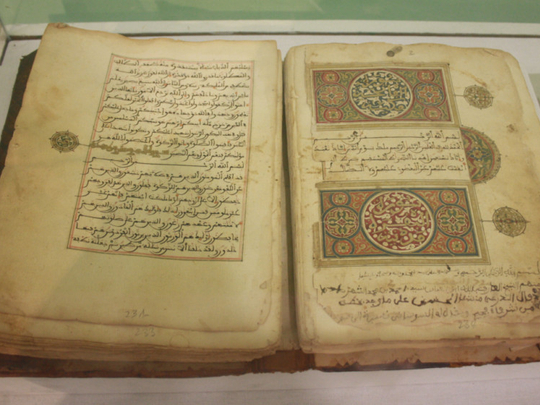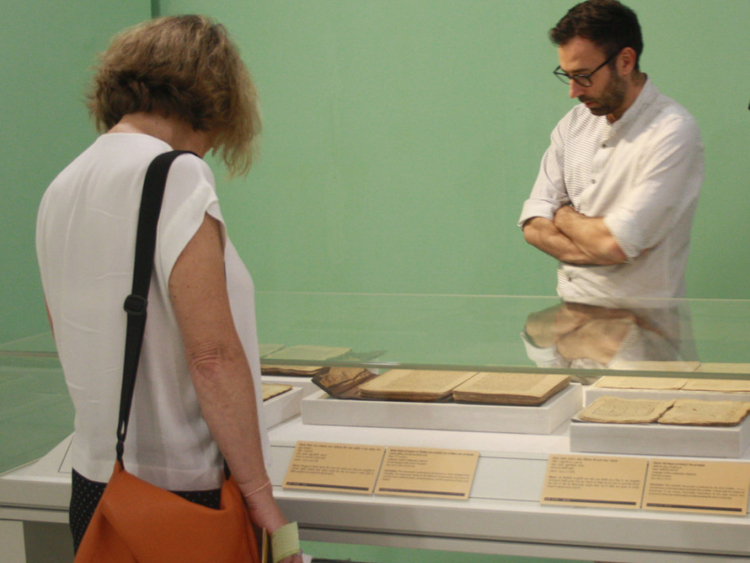
NEW DELHI: There is the old riposte about mentioning the name Timbuktu for anything that suggests a far away distance that cannot be imagined. It probably is not a stretch to say that many people imagine Timbuktu does not even exist. Well, it does. And a collection of rare manuscripts that are wowing visitors at the National Museum in the Indian capital throw new light on this ancient place and its valuable contribution to history.
The question though: where is Timbuktu? This ancient city, in the West African country of Mali, is situated 20km north of River Niger.
The great Arab historian Abd Al Sadi in his chronicle, Tarik Al Sudan, traces the foundation of Timbuktu to AD1100. Situated at the gateway to the Sahara desert, Timbuktu was the product of the convergence of West African and Arab influences and served as the gathering point for scholars, traders and travellers.
In 2012, Timbuktu was included in Unesco’s ‘List of World Heritage in Danger.’
And now, over 800,000 selected manuscripts of Timbuktu are travelling across the globe thanks to the Unesco designated World Heritage Knowledge Society.
The collection on view in New Delhi, comprising Timbuktu’s long history, is from the Mamma Haidara Memorial Library, a private manuscript library based in Timbuktu. It was founded by Abdul Kader Haidara, a Malian native and named in honour of his father.
Haidara has been relentless in his efforts to raise international awareness of the importance of the manuscripts and generate funds to preserve Africa’s written heritage.
“These rare pieces, dating from the 11th century, have rarely travelled outside Mali and have come to India for the first time,” said Haidara, who is also the CEO of Savama-DCI, an NGO working towards protecting manuscripts.
Speaking of the wealth of information contained in the manuscripts, an official of the National Museum told Gulf News, “The Timbuktu manuscripts are known to be copies of the classics and original works on diverse subjects including Sufism, governance, jurisprudence, language, grammar, mysticism, arithmetic, astronomy and correspondence between political and religious leaders. All these are in Arabic and signify that Timbuktu in the pre-modern and early modern periods was a centre of Islamic learning and scholarship.
Literary history
“When talking about the literary history of Timbuktu, a prominent name is Ahmad Baba, the 16th-century scholar whose life was dedicated to disseminating knowledge,” the official said.
As a tribute to this scholar, in 1970, the Ahmad Baba Institute, manuscript library and a research centre was opened in the city. Soon, several private libraries came up.
Since the 16th century, Haidara’s ancestors had been acquiring manuscripts and soon built up a library. His father, Mohammad Haidara, popularly known as Mamma, was a self-taught scholar of Islamic sciences and judge, who amassed thousands of rare handwritten books that were added to the library.
Haidara’s interest in manuscripts grew after his father’s death in 1981. He joined the Ahmad Baba Institute at the age of 17 and trained himself in cataloguing and conservation techniques. Twelve years later, he quit the job and tended to his family archive, setting up the Mamma Haidara Memorial Library.
During 2010 and thereafter, while Timbuktu was the victim of conflict and violence, prominent libraries, including the Ahmad Baba Institute, were set on fire.
Many feared the city’s treasure trove of ancient manuscripts had been destroyed. But Haidara, along with family, friends and colleagues, had already removed most documents from major collections, hiding them in private homes.
The manuscripts were evacuated from Timbuktu hidden in cars, carts and canoes, with boxes being concealed under crates of vegetables and fruits and taken to Bamako, in Mali.
Now, Haidara faces the gigantic task of preserving them. “These have to be taken care of and safeguarded not only from thieves and smugglers, but also from dryness, humidity and desertification. The manuscripts have several enemies and to protect them is an everyday struggle.”
Rare Islamic manuscripts on display
Some of the priceless manuscripts on display at the National Museum in New Delhi that throw light on the major Islamic contributions and Arab heritage:
Shar ‘ala Mukhtasar Khalil (16th century): This is a treatise of jurisprudence according to the Melkite (Greek) Catholic Church’s Byzantine rite liturgical traditions. It addresses the issues of worship, personal status and transactions. This book is extensively studied in Western Africa and served as a legal benchmark for the ceremonial practices of the region. In the margins, this copy contains the notes of several scholars from Tekrour (the present-day Senegal and Lake Chad).
Tuhfat al-Ahbab wa Nukhbat al-A’jab (17th century): This is a travel account written by the great traveller Abu Hamid Al Garnati. Al Gharnati, so named after his hometown of Granada (“Garnata”), travelled from the Arab West to the northern- and easternmost reaches of the Islamic world and beyond. In this book, he discusses historical facts encountered on his visits and description of the topography. This travelogue records his visits to major parts of Egypt, Iraq, Europe and other places of the world.
Mir at al-Tullab ‘ala al-Lughat wa al-Ma ‘ani (18th century): This manuscript is written by Al Haj Salim Al Zaghawi Al Kasani Al Maghribi. It is considered one of the best treatises on the science of language. It discusses Arabic lexicography and philology in a lucid manner. This copy was manually restored and has notes/explanations in the margins in local African languages.
Nawazil al-Qasri (19th century) manuscript by al-Qasri bin Muhammad bin al-mukhtar bin ‘Uthman al-Walati: This is compiled as per the Maliki School of Thought. It deals with jurisprudence relating to subjects such as marriage, divorce, worker’s rights, food and nutrition as well as commerce and trade. It is considered one of the best books on the subject due to its compilation in a well-organised form.














